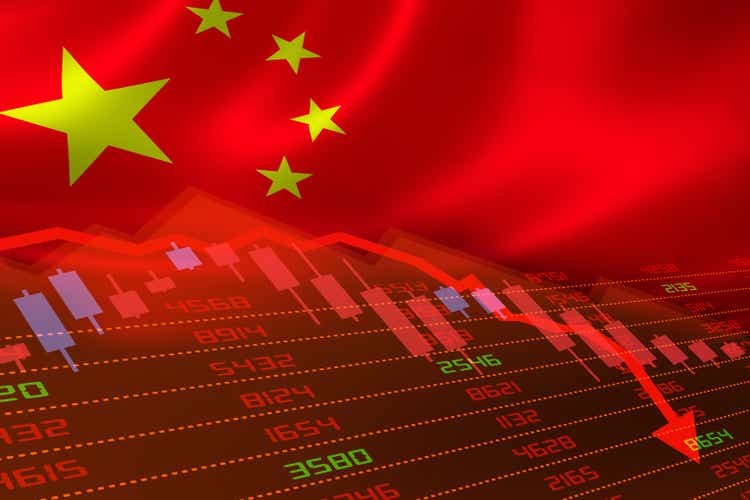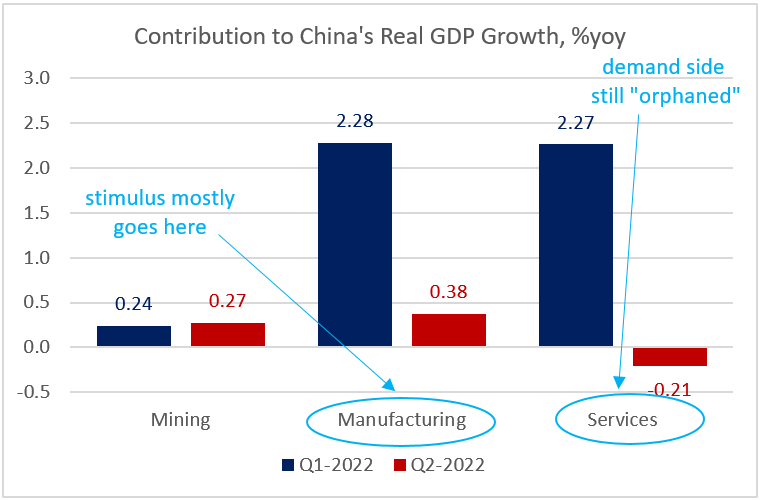ronniechua
China’s Q2 GDP was weaker than expected, but higher-frequency data shows a rebound. Can China close the gap between the growth forecast and the official target with the same approach to policy stimulus?
China Growth Slowdown
Chinese stocks reacted negatively to China’s dismal Q2 GDP print, even though June’s activity data showed signs of a rebound. The Q2 real GDP growth dropped by 2.6% in sequential terms and was barely positive on a year-on-year basis (0.4%). The services sector was hit the hardest – posting a negative year-on-year growth for the first time since the pandemic (Q3 2020). But manufacturing also showed a comparable drop in the contribution to quarterly growth (see chart below). China’s zero-COVID policy was the main culprit, and the removal of some restrictions was already visible in June’s industrial production, retail sales and investments. (Much) stronger than expected credit aggregates for June suggest that domestic activity should show even better results in July and August – naturally, provided there are no new lockdowns.
China Policy Stimulus
The question is whether the prospective Q3 rebound (fingers crossed) would significantly narrow (or close) the widening gap between the 2022 growth forecast and the official growth target. As we said, easier movement restrictions are a huge plus – but given that China’s zero-COVID policy will not go anywhere any time soon, there is an ever-present risk that lockdowns will be back. We also keep an eye on the new growth headwind, which some commentators call the “mortgage payment crisis”. And this brings us back to the additional stimulus. Today’s reports that the central bank decided to keep the 1-year medium-term lending facility rate unchanged at 2.85% tell us that this is pretty much business as usual as regards the fiscal-monetary breakdown (emphasis on fiscal support). Finally, authorities continue to target supply side (especially infrastructure) to prop up growth, while demand side remains an afterthought. The next stop on the growth front is the release of July’s activity gauges at the end of the month.
China Growth – Global Implications
China’s growth trials and tribulations can have a significant impact on some global commodity prices – with major implications for some emerging markets (EM) currencies, like the Chilean peso. Granted, concerns about the policy direction after the presidential elections helped to drive the peso down this year, but this happened against the backdrop of falling copper prices. The central bank tried to stay away from the FX market, but finally gave up yesterday, announcing a USD25B FX intervention program, making the Chilean peso the happiest EMFX on the block (up by 438bps against the U.S. dollar, according to Bloomberg LP, as of 9:40am ET). Every little bit helps, when dealing with persistent inflation pressures – including a stronger/stable currency. Stay tuned!
Chart at a Glance: China – Universal Slowdown, Lopsided Stimulus
VanEck Research; Bloomberg LP
PMI – Purchasing Managers’ Index: economic indicators derived from monthly surveys of private sector companies. A reading above 50 indicates expansion, and a reading below 50 indicates contraction; ISM – Institute for Supply Management PMI: ISM releases an index based on more than 400 purchasing and supply managers surveys; both in the manufacturing and non-manufacturing industries; CPI – Consumer Price Index: an index of the variation in prices paid by typical consumers for retail goods and other items; PPI – Producer Price Index: a family of indexes that measures the average change in selling prices received by domestic producers of goods and services over time; PCE inflation – Personal Consumption Expenditures Price Index: one measure of U.S. inflation, tracking the change in prices of goods and services purchased by consumers throughout the economy; MSCI – Morgan Stanley Capital International: an American provider of equity, fixed income, hedge fund stock market indexes, and equity portfolio analysis tools; VIX – CBOE Volatility Index: an index created by the Chicago Board Options Exchange (CBOE), which shows the market’s expectation of 30-day volatility. It is constructed using the implied volatilities on S&P 500 index options.; GBI-EM – JP Morgan’s Government Bond Index – Emerging Markets: comprehensive emerging market debt benchmarks that track local currency bonds issued by Emerging market governments; EMBI – JP Morgan’s Emerging Market Bond Index: JP Morgan’s index of dollar-denominated sovereign bonds issued by a selection of emerging market countries; EMBIG – JP Morgan’s Emerging Market Bond Index Global: tracks total returns for traded external debt instruments in emerging markets.
The information presented does not involve the rendering of personalized investment, financial, legal, or tax advice. This is not an offer to buy or sell, or a solicitation of any offer to buy or sell any of the securities mentioned herein. Certain statements contained herein may constitute projections, forecasts and other forward looking statements, which do not reflect actual results. Certain information may be provided by third-party sources and, although believed to be reliable, it has not been independently verified and its accuracy or completeness cannot be guaranteed. Any opinions, projections, forecasts, and forward-looking statements presented herein are valid as the date of this communication and are subject to change. The information herein represents the opinion of the author(s), but not necessarily those of VanEck.
Investing in international markets carries risks such as currency fluctuation, regulatory risks, economic and political instability. Emerging markets involve heightened risks related to the same factors as well as increased volatility, lower trading volume, and less liquidity. Emerging markets can have greater custodial and operational risks, and less developed legal and accounting systems than developed markets.
All investing is subject to risk, including the possible loss of the money you invest. As with any investment strategy, there is no guarantee that investment objectives will be met and investors may lose money. Diversification does not ensure a profit or protect against a loss in a declining market. Past performance is no guarantee of future performance.
Editor’s Note: The summary bullets for this article were chosen by Seeking Alpha editors.


Be the first to comment